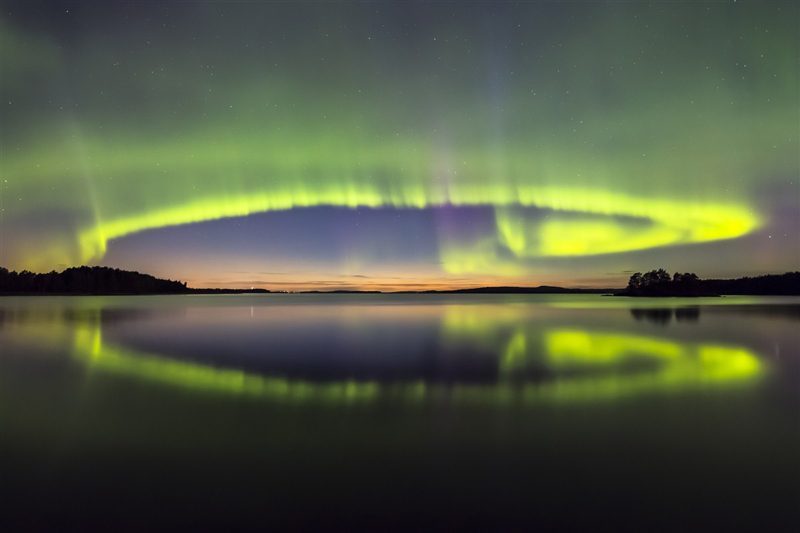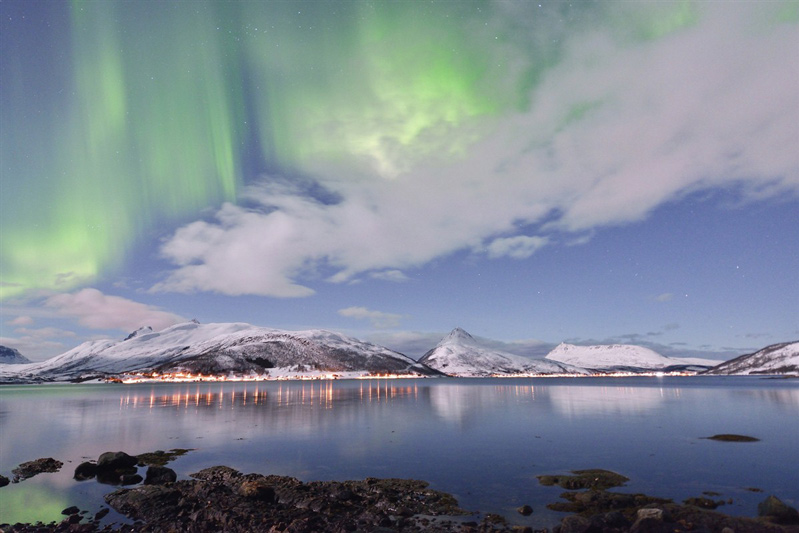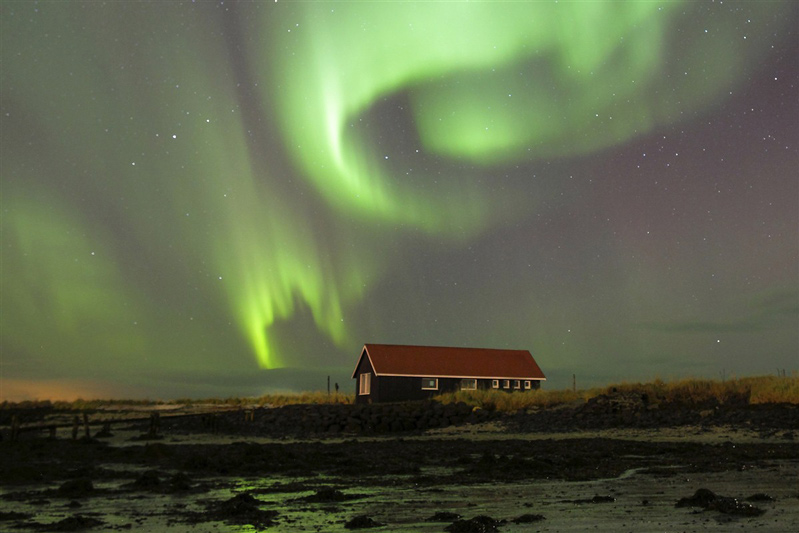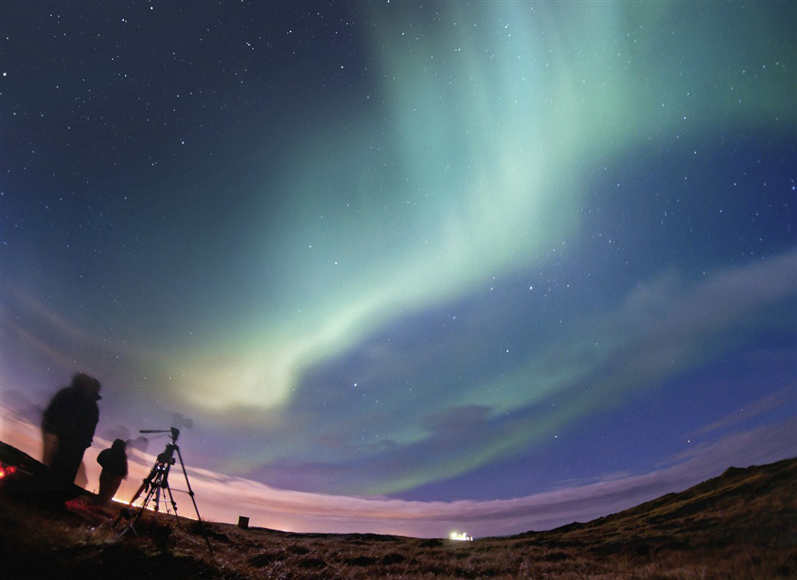In the northern-most reaches of the Earth, there’s magic in the skies. It’s an elusive, colourful sort of mystical presence that transforms the heavens into a luminescent light show. Read on to discover everything you need to know about this most magnificent of displays…
There’s nothing quite like the Northern Lights – an otherworldly display of vibrant colour that streaks across the sky. Nature’s greatest show has fascinated people for thousands of years and the unpredictability and rarity of the Northern Lights only adds to the allure of hunting them down and witnessing the majestic natural phenomenon in person. It’s a heart-stopping experience that’s at the top of most traveller’s ultimate wish-lists.
What are the Northern Lights?
The Aurora Borealis, also known as the Northern Lights, is a show of colourful light that pirouettes in the sky when electrically charged particles released from the sun collide with the Earth’s atmospheric gases. These lights occur around the magnetic poles of the southern hemisphere as well as the north, an area known as the auroral zone. The phenomenon in the south is called the Southern Lights or Aurora Australis.
How are the colours of the Northern Lights formed?
The Earth’s atmosphere is made up of different atoms, like oxygen and nitrogen, and it is these atoms colliding with solar particles that cause the colours so characteristic of the northern lights. The coloured auroras vary depending on the atoms involved in the collision and the composition of the Earth’s atmosphere at different heights. The brightest and most frequent hue is yellow and green, which is induced by encounters with oxygen located approximately 60 miles above sea level. Shades of pink, violet and blue are also often observed.

Petri Jauhiainen/Vastavalo/VisitFinland
Where to see Northern Lights?
Your best bet in tracking down the elusive Northern Lights is to head to the auroral zone, an area centred on the magnetic North Pole that extends over parts of Scandinavia, Iceland, Greenland, Canada, Alaska and Siberia. Here are eight brilliant destinations where you can admire the Aurora Borealis:
1
Canada
Canada is one of the best places on the planet to catch a glimpse of the Northern Lights as part of the country is positioned directly underneath the auroral oval, a ring above the Earth’s North Pole that displays an aurora. Head to northern Canada, in the wilderness and away from light pollution, for an almost guaranteed chance to see the most spectacular natural spectacle.
2
Alaska
In Alaska two cities, Fairbanks and Nome, count more than 200 aurora days per year, so the possibility of catching them here is excellent. Watch and wait in the crisp cold as the landscape ignites!
3
Greenland
Greenland is an ideal location for a trip hunting the Northern Lights – perfectly positioned and less touristy than other destinations, you don’t have to stray far from the capital, Nuuk, to watch in wonder; Kangerlussuaq, Sisimiut and Ilulissat are all fantastic options.
4
Iceland
Iceland is one of the cheapest and easiest destinations for those wishing to make the auroral journey – hop on a flight to Reykjavik then swap the artificial lights of the capital for something a touch more magical with a jaunt to a number of places just a few hours away. Go to Thingvellir National Park for an easy diversion from city sightseeing, or head further afield in the northern reaches around Lake Mvvatn, then take your front-row seat and wait for the show to begin.
5
Scotland
It might not be known for it, but during clear, dark, winter nights between December and February, it’s possible to catch the Northern Lights in action in Scotland. The Shetland Isles are closest to the North Pole, so head there for your best chance to get closer to the cosmos.
6
Norway
The climate is often milder in Norway and the sheer number of places to go aurora spotting is incredible, making it one of the best countries in Europe, and the world, to catch a flash of the hypnotic Northern Lights. Whether you’re in the Lofoten Islands, the North Cape, or even remote Svalbard, you’re spoiled for choice. Just over a mile away from the centre of Tromsø lies the magnificent Prestvannet Lake. A nature reserve devoid of any artificial light, it’s just the ticket for a peaceful, astounding view of the lights that’s just a 20-minute walk from the city centre.
7
Finland
Seeing the Northern Lights in Finland is a dream for many travellers; set your compass for Northern Lapland where the luminous bursts of colour in the heavens appear around every other night between September and March, depending on the weather. In southern Finland, the phenomenon is visible around 10 to 20 nights a year.
8
Sweden
In Sweden, just like anywhere else on earth, you’re at the mercy of nature in a quest to gaze at the Aurora Borealis, but kick off your trip in Kiruna, the country’s northernmost town, for your greatest chance to witness them for yourself. This city, situated in the province of Lapland, is the best corner of Sweden to be overwhelmed by the beauty of the skies.

Getty Images
›› More info on our article Where Are The Best Places To See The Northern Lights?
When is the best time to see the Northern Lights?
Generally speaking, the long dark nights between September and March offer the best viewing conditions for the Aurora Borealis. But it depends on where you’re going; there are destinations where it’s sometimes possible to catch the lights from the end of August until April, but the winter season brings with it earlier, darker evenings, which offers a greater chance to score a good view. General forecasts from The Alaska Geophysical Institute are available to determine the likelihood of aurora appearing, but the weather will always play a part in your chances of catching a glimpse.
For more detail on specific countries, check out our article When Is The Best Time To See The Northern Lights?
What can I do to increase my chances of seeing the Northern Lights?
There’s a certain amount of luck involved in spotting the mysterious, mystical Northern Lights, but there are ways to maximise your chances; head outside after dark, away from city lights and other pollution, to a place where the heavens are at their darkest. In general, the Northern Lights are most active shortly before midnight, but they’re visible any time once the sun sets and the skies turn black. Choose a clear viewpoint and a cloudless winter sky and pay attention to the lunar calendar – the brightness of a full moon weakens the intensity of the aurora.

Getty Images
If an aurora is seen early in the evening, is it likely another will follow?
Auroras can dance in the sky for several minutes, hours or even days, so one sighting early on in your trip, or on a night, does not mean the show’s over. Many hotels in prime Northern Lights locations offer alerts to warn guests when an aurora will occur – get ready to jump in the middle of the night when the phone rings for your best chance to watch the sky streak with colour.
Myths and legends around the Northern Lights
Named after the Roman goddess of the dawn, Aurora, the Northern Lights appeared at the earliest hours of our earth. For centuries, humans have been fascinated by the atmospheric arabesques that illuminate the skies – in ancient times, both in the West and in China, the Northern Lights were regarded as snakes or dragons in the sky. Tales of marvellous celestial monsters and deities sprang forth and such stories taught man to respect, fear and idolise the lights in the sky.
In most countries, either Aurora Borealis or Northern Lights are the terms used for the natural light show, but for the Finns, the word ‘Revontulet’, translated as ‘fox fire’ is preferred. This name finds its origin in folklore surrounding arctic foxes that run through the skies so fast that their tales catch fire and the resulting streaks of colour are the sparks from their fur. In some countries, the aurora is described as the last breath of brave soldiers – the lights are a glittering, vibrant bridge that leads fallen warriors to their final resting place. In Iceland, the Northern Lights were said to relieve the pain of childbirth, but that pregnant women should never look at them directly, otherwise their child would be born with eye problems.
Since human civilisation began, the Northern Lights have been associated with magic and mystery. And despite understanding the science behind the majestic spectacle that paints the northern sky today, the Aurora Borealis retains as much wonder as it ever has.

Getty Images
Cover Picture : Damlow/Getty Images/iStockphoto

